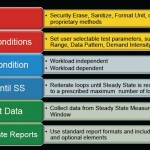 Need an abbreviated version of the SNIA SSD Performance Test Specification (PTS) in a hurry? Jamon Bowen of Texas Memory Systems (TMS) whipped up a simple implementation of certain key parts of the PTS that can be run on a Linux system and interpreted in Excel.
Need an abbreviated version of the SNIA SSD Performance Test Specification (PTS) in a hurry? Jamon Bowen of Texas Memory Systems (TMS) whipped up a simple implementation of certain key parts of the PTS that can be run on a Linux system and interpreted in Excel.
It’s a free download on his Storage Tuning blog.
This is a boon for anyone that might want to run a internal preliminary test before pursuing a more formal route.
The bash script uses the Flexible I/O utility (FIO) to run through part of the SSSI PTS. FIO does the heavy lifting, and the script manages it. The script outputs comma separated (CSV) data and the download includes an Excel pivot table that helps format the results and select the measurement window.
Since this is a bare-bones implementation the SSD must be initialized manually before the test script is run.
The test runs the IOPS Test from the PTS. This test covers a range of block sizes, read/write ratios and iterates until the steady state for the device is reached (with a maximum of 25 iterations). Altogether the test takes over a day to run.
Once the test is complete, the downloadable pivot tables allow users to select the steady-state measurement window and report the data in a recommended format.
See Mr. Bowen’s blog at http://storagetuning.wordpress.com/2011/11/07/sssi-performance-test-specification/ for details on this valuable download.

I want to get the hp envy 14 and I would either get 250GB 7200RPM or 160GB Solid State Drive. Is it worth getting the solid state? It is also quite a lot more expensive.
Whether an HDD or SSD is the best choice for you entirely depends upon how you’ll use it. An SSD will give you faster boot time and qucker access to files and applications. An SSD will not show as much improvement when playing movies or transferring large files.
Another option is to go with an HDD and an inexpensive low capacity SSD. You’ll get faster boot and qucker accss to files than an HDD, but not quite as much performance improvement as a large capacity SSD.